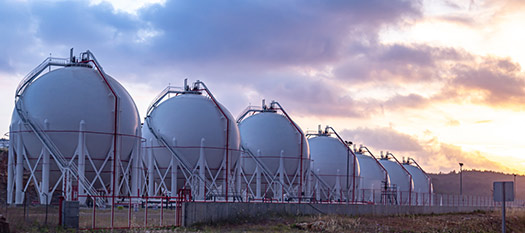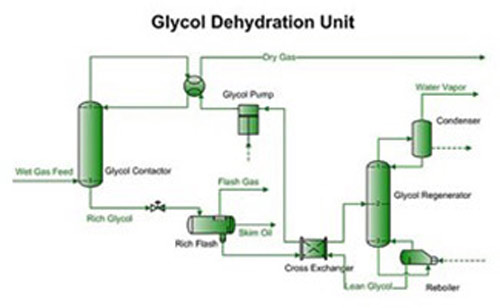March 2024, Vol. 251, No. 3
Features
Addressing Challenges in Carbon Capture, Storage Deployment
By Anuj Rastogi, Mechanical Engineer, Fluor Daniel India Private Ltd.
(P&GJ) — While the use of renewables, improved energy efficiency and electric vehicles are areas of focus, oil and natural gas will continue to be in demand for petrochemicals and fueling transportation by land, sea and air.
Greater fossil fuel consumption means more carbon dioxide (CO2) emissions. CO2 is the primary greenhouse gas (GHG) and its rising levels cause extreme climate events like temperature rise and shift in rainfall/snow patterns. This article addresses the various available technologies used for capturing carbon, reducing CO2 emissions and utilizing the captured carbon for monetization.
The article also addresses barriers in deploying carbon capture, utilization and storage (CCUS) technologies in various industries.
CCUS is the process of capturing CO2 formed during power generation and industrial processes and preventing it from being emitted into the atmosphere. Captured CO2 is then further processed and either permanently stored thousands of feet below the surface or transported to other businesses to produce products (e.g., synthetic fuels, building materials, urea, carbonated drinks) or used for enhanced oil recovery.
CCUS technologies have significant potential to reduce CO2 emissions from new and existing coal- and gas-fired power plants, petrochemical complexes, refineries and other industrial processes. CCUS technologies play an important role in reducing the carbon intensity of industrial operations to meet the net-zero emissions ambitions of the Paris agreement by 2050.
CCUS involves three major steps: capture, processing and transport, and storage or utilization (Figure 1). Various technologies can be used to capture CO2 at the source.
Post-combustion carbon capture is the most common technology used in petrochemical facilities, power generation plants and other industries to capture CO2 from exhaust gases created by burning fossil fuels. These include pressure swing adsorption (PSA), amine absorption and cryogenic separation technologies for CO2 separation.
Amine-based absorption is the most common technology used for post-combustion capture. Generally, exhaust gases bring in contact with a liquid solvent, typically an aqueous amine solution. The amine selectively absorbs the CO2, capturing more than 90% and preventing nitrogen and oxygen from being released into the atmosphere.
A CO2-rich amine is regenerated by stripping the CO2 out of the liquid with steam, enabling the lean amine to be recycled to the absorber while producing a concentrated CO2 stream. The captured CO2 is then compressed and cooled in liquid form.
Pre-combustion carbon capture This is primarily used in industrial processes and involves removing CO2 from fossil fuels before combustion. It is based on gasification processes where a feedstock (e.g., coal) is partially oxidized in steam and oxygen/air under high temperature and pressure to form synthetic gas (syngas).
Syngas is a mixture of hydrogen (H2), carbon monoxide (CO), CO2 and smaller gaseous components, such as methane. The syngas is further processed to convert CO and water to H2 and CO2. The CO2 is then captured, and the H2-rich fuel is combusted.
Oxy-fuel combustion occurs in a nearly pure oxygen environment, as opposed to air. Oxy-fuel combustion generates flue gas with extremely high CO2 and water vapor concentrations. Low-temperature dehydration and desulfurization processes can easily produce a high-purity CO2 stream from this flue gas.1
Mobile Capture
Work is underway to develop mobile carbon capture and storage (CCS) technologies for the transport sector. The prototype developed by Aramco can capture 40% CO2 from the exhaust of a heavy-duty truck.2
This CO2 is stored in onboard tanks where the gas can be unloaded at fuel stations and then sent to a central location for re-use or sequestration. Once fully developed, this technology can be deployed to marine vessels, heavy-duty trucks and other mobile applications to capture the CO2 at its source.
Processing, Transport
Captured CO2 contains water vapors that must be removed due to the risk of corrosion and hydrate formation. The level of accepted water content after dehydration of CO2 depends on the use of the captured CO2.
Several different gas dehydration methods are available. The simplest dehydration methods are cooling, water condensing and gas/water separation. Other methods are dehydration by absorption (for large scale), adsorption (for low water levels) or using membranes (for low flow).
The most traditional method for large-scale dehydration is absorption into triethylene glycol (TEG). The water from captured CO2 is removed by absorption into TEG, followed by desorption (Figure 2).
The dehydrated CO2 is then transported in three states: gas, liquid and solid. Commercial-scale transport uses tanks, pipelines and ships for gaseous and liquid CO2. Gas at atmospheric pressure occupies such a large volume that extensive facilities are needed. The gas must be compressed, and compressed gas is transported by pipeline.
Volume can be further reduced by liquefaction and solidification. Solidification requires much more energy than other options and is inferior from a cost and energy viewpoint; therefore, it is not preferred.
Utilization, Storage
Captured CO2 can be put to productive use in enhanced oil recovery (EOR) and the manufacture of syngas and building materials or be stored in underground geologic formations.
In EOR, CO2 is injected to extract deep oil and gases from developed oil and gas reservoirs. These reservoirs offer geologic storage potential and economic opportunity. Revenue from selling captured CO2 to EOR operators could help to meet the cost of capture technology at power plants and industrial facilities.
Captured CO2 is also used as feedstock in manufacturing various products; however, this is not a permanent solution. These products, when degraded, will release CO2 back into the atmosphere. However, using CO2 to make syngas can help meet energy demand and reduce fossil fuel consumption.
Deployment Challenges
The most significant barrier to the development of CCUS technologies is the high equipment and energy cost needed for the capture and compression phases. Capturing the CO2 decreases a plant’s efficiency and increases water use. Any additional costs posed by these (and other) factors can make a CCUS project financially nonviable. Additional research and development are required to optimize CCUS technology to reduce the overall cost of implementing a CCUS project.
In addition to the high costs of capture technology, transporting captured CO2 is also very costly. Significant energy is required to compress CO2 for transporting it via pipeline or ship. Moreover, the compressors, onsite storage and pipelines themselves are expensive.
Additionally, captured CO2 must be processed to remove impurities (including water), which can cause damage to pipelines and lead to leaks and explosions as the compressed fluid rapidly expands into a gas. Such processing facilities add further costs to CCUS projects.
Conclusion
CCUS deployment is viewed as the most practical decarbonization method in petrochemical facilities, power generation plants and other industries. It can address global climate issues by reducing GHG emissions and contributing to the 2050 net-zero emissions goal.
To accelerate CCUS deployment, local regulations and policies must be in place to enforce the carbon capture project at power generation plants, industrial facilities and petrochemical complexes. Governments should also incentivize CCUS projects and other businesses using captured CO2.
Sources:
- Zhang, X., et al., “Advances in technologies for in situ desulfurization of biogas,” ScienceDirect, 2022, online: https://www.sciencedirect.com/science/article/abs/pii/S2468012522000037
- Oil and Gas Climate Initiative, “Carbon capture, utilization and storage,” online: https://www.ogci.com/case-study/aramco-advancing-carbon-capture-in-the-transport-sector/
Author: Anuj Rastogi is a mechanical engineer with Fluor Daniel India Private Ltd., New Delhi, and has been with the company for 12 years. He has more than 17 years of packaged equipment experience and earned a bachelor’s in mechanical engineering.
Williams Acquires Gulf Coast Storage, Pipeline Assets
(P&GJ) — Williams reached an agreement to acquire a portfolio of natural gas storage assets from an affiliate of Hartree Partners LP for $1.95 billion.
The transaction includes six underground natural gas storage facilities located in Louisiana and Mississippi with total capacity of 115 Bcf, as well as 230 miles of gas transmission pipeline and 30 pipeline interconnects to LNG markets, and connections to Transco.
The six natural gas storage facilities include four salt domes with combined capacity of 92 Bcf and two depleted reservoirs with combined capacity of 23 Bcf.
The facilities have injection capacity of 5 Bcf/d and withdrawal capacity of 7.9 Bcf/d, among the highest of any natural gas storage platform in the United States.
Two of the facilities, Pine Prairie and Southern Pines, are directly connected with Transco and are well positioned for expansions.
“This premier natural gas storage platform on the Gulf Coast fits squarely within our strategy to own and operate the best assets connected to the best markets to serve growing demand driven by LNG exports and power generation,” said Williams President and Chief Executive Officer Alan Armstrong.
Since 2010, U.S. demand for natural gas has grown by 56%, while gas storage capacity has only increased 12%.








Comments